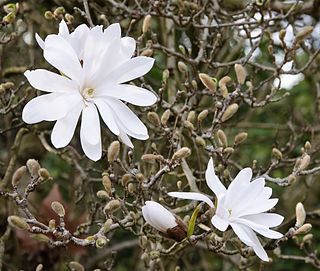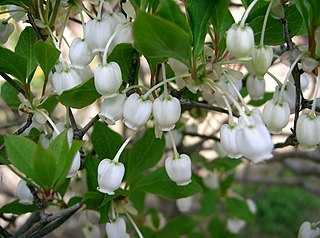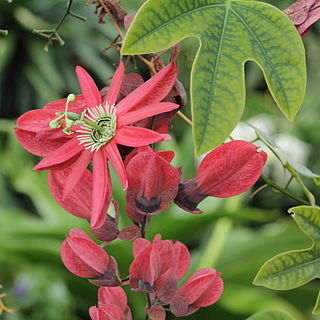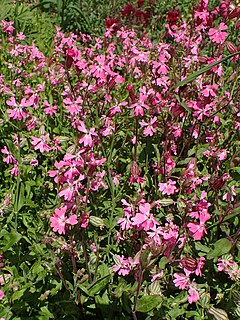
Picea mariana, the black spruce, is a North American species of spruce tree in the pine family. It is widespread across Canada, found in all 10 provinces and all 3 territories. It is the official tree of the province of Newfoundland and Labrador and is that province's most numerous tree. The range of the black spruce extends into northern parts of the United States: in Alaska, the Great Lakes region, and the upper Northeast. It is a frequent part of the biome known as taiga or boreal forest.

Fritillaria meleagris is a Eurasian species of flowering plant in the lily family Liliaceae. Its common names include snake's head fritillary, snake's head, chess flower, frog-cup, guinea-hen flower, guinea flower, leper lily, Lazarus bell, chequered lily, chequered daffodil, drooping tulip or, in the British Isles, simply fritillary. The plant is native to the flood river plains of Europe where it grows in abundance.

Magnolia stellata, sometimes called the star magnolia, is a slow-growing shrub or small tree native to Japan. It bears large, showy white or pink flowers in early spring, before its leaves open. This species is closely related to the Kobushi magnolia, and is treated by many botanists as a variety or even a cultivar of that. However, Magnolia stellata was accepted as a distinct species in the 1998 monograph by Hunt.

Phoenix roebelenii, with common names of dwarf date palm, pygmy date palm, miniature date palm or robellini palm, is a species of date palm native to southeastern Asia, from southwestern China, northern Laos and northern Vietnam,.

Erica tetralix, the cross-leaved heath, is a species of flowering plant in the family Ericaceae, native to western Europe, from southern Portugal to central Norway, as well as a number of boggy regions further from the coast in Central Europe such as Austria and Switzerland. In bogs, wet heaths and damp coniferous woodland, E. tetralix can become a dominant part of the flora. It has also been introduced to parts of North America.

Berberis thunbergii, the Japanese barberry, Thunberg's barberry, or red barberry, is a species of flowering plant in the barberry family Berberidaceae, native to Japan and eastern Asia, though widely naturalized in China and North America. Growing to 1 m (3.3 ft) tall by 2.5 m (8.2 ft) broad, it is a small deciduous shrub with green leaves turning red in the autumn, brilliant red fruits in autumn and pale yellow flowers in spring. Numerous cultivars are available as ornamental plants suitable for hedging.

Genista aetnensis, the Mount Etna broom, is a species of flowering plant in the legume family Fabaceae. It is a large shrub or small tree endemic to Sicily and Sardinia where it is associated with sunny, open landscapes and poor, stony soil. It is a very common constituent of the garigue plant communities, Mediterranean shrubby vegetation, around the lower slopes of Mount Etna, hence its Latin specific epithet aetnensis.

Narcissus triandrus is a species of dwarf bulbous flowering plant native to France, Spain and Portugal. With the common name angel's tears, the plant grows to 30 cm (12 in) in height, and has pendent cream to yellowish flowers, with strongly reflexed perianth segments, in late spring.

Ornithogalum nutans, known as drooping star-of-Bethlehem, is a species of flowering plant in the family Asparagaceae, native to Europe and South West Asia. It is a bulbous perennial growing to 20–60 cm (8–24 in) tall by 5 cm (2 in) wide, with strap-shaped leaves and green striped, pendent grey-white flowers in spring. It is cultivated, and has naturalized, outside its native range, for example in North America. It has become extremely invasive along the Chesapeake and Ohio Canal in Maryland. At least in North America, it is not as common as Ornithogalum umbellatum.

Agapanthus inapertus, the Drakensberg agapanthus, drooping agapanthus, or closed African lily, is a species of flowering plant in the family Amaryllidaceae, native to open grasslands, forest margins and mountainous, rocky areas of Mozambique, Eswatini (Swaziland), and South Africa.

Enkianthus is a genus of shrubs or small trees in the heath family (Ericaceae). Its native range is in Asia, as far west as the eastern Himalayas, as far south as Indochina, and as far north and east as China and Japan.

Passiflora racemosa, the red passion flower, is a species of flowering plant in the family Passifloraceae, native to Brazil. It is an evergreen climber growing to 5 m (16 ft), with simple or 3-lobed leaves to 10 cm (4 in) long, and vivid red flowers borne in summer. The flowers are 12 cm (5 in) in diameter, with purple and white coronas. They are followed by oblong green fruits.

Pennisetum alopecuroides, the Chinese pennisetum, Chinese fountaingrass, dwarf fountain grass, foxtail fountain grass, or swamp foxtail grass, is a species of perennial grass native to Asia and Australia. The culms are erect, and 60–100 cm long. The leaf-blades are erect or drooping; flat, or conduplicate or involute (spiral); and from 10–45 cm long by 3–6 mm wide.

The hardiest of Enkianthus species is E. campanulatus, a medium-sized, narrow, upright, deciduous shrub. Its bright green glossy foliage gives brilliant coppery to red fall colors. In spring it offers a profusion of bell-shaped, creamy white flowers with red veins, similar to those of the distantly related Pieris.

Enkianthus perulatus (dodan-tsutsuji) is a species of flowering plant in the family Ericaceae, native to Japan. It is a compact, slow-growing, deciduous shrub eventually growing to 2 m tall and wide. Pendent umbels of pure white, bell-shaped flowers in spring are followed in autumn by brilliant red and yellow leaf colours.

Pieris floribunda is a North American species of broadleaf evergreen shrub, a member of the fetterbush genus in the blueberry family (Ericaceae). It is commonly known in North America as mountain fetterbush or mountain andromeda. All parts of Pieris floribunda are poisonous if ingested. In landscapes it should be grown in full to part shade, out of windy locations, and have a good quality soil with much organic matter with acidity of pH 4.5 to 6.5.
Calochortus cernuus is a rare Mexican species of plants in the lily family. It is found only in the hills surrounding the community of Tepoztlán in the State of Morelos south of Mexico City, northeast of Cuernavaca.

Narcissus moschatus, the swan's neck daffodil, is a species of Narcissus native to the Pyrenees. It has gained the Royal Horticultural Society's Award of Garden Merit.

Silene pendula, called the nodding catchfly or drooping catchfly, is a species of flowering plant in the genus Silene, native to Italy, Greece, and Turkey, and introduced to scattered locations in North America, South America, Africa, Europe and Asia. A number of cultivars are available. A 2020 study showed with certainty that, despite their morphological similarities, Silene cisplatensis is not synonymous with Silene pendula.

Bergenia purpurascens, the purple bergenia, is a species of flowering plant in the family Saxifragaceae, native to Nepal, the eastern Himalayas, Assam, Tibet, south-central China, and Myanmar. The species, its putative variety Bergenia purpurascens var. delavayi, and its cultivar 'Irish Crimson' have all gained the Royal Horticultural Society's Award of Garden Merit. A useful feature in the garden is the visual interest that its foliage provides by turning a deep beet red during the winter.


















